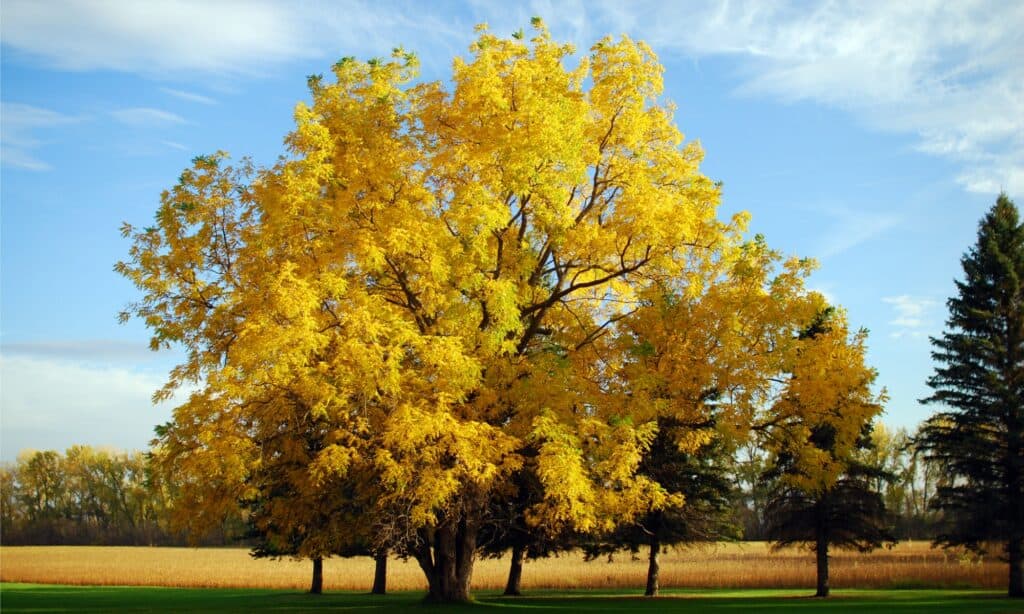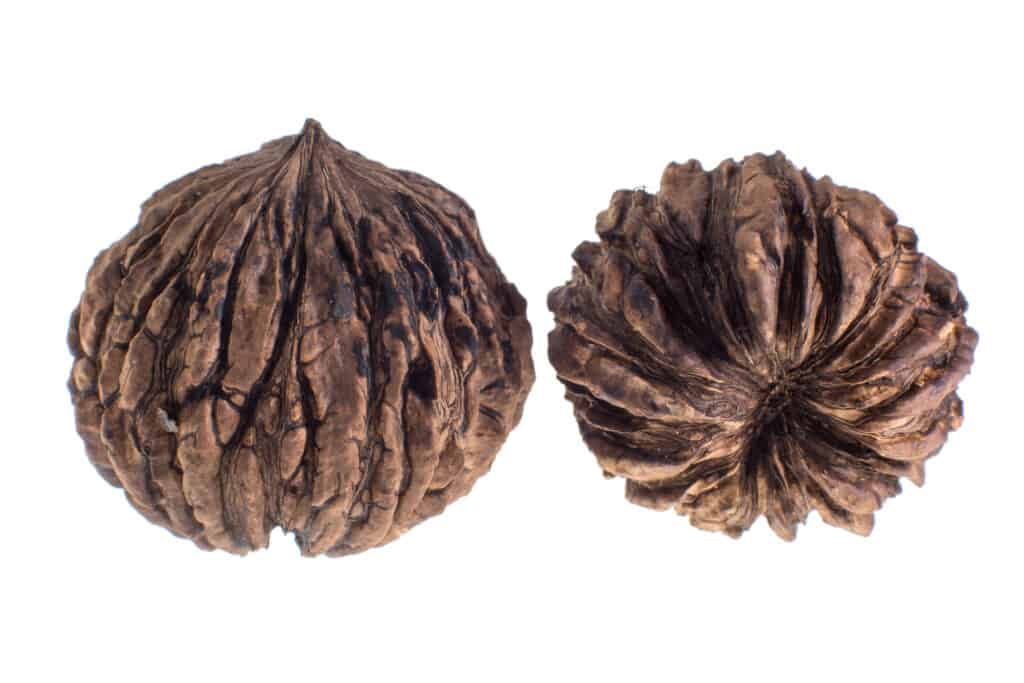Have you always wondered what the differences are between an English walnut vs black walnut? These two walnut tree varieties offer different uses, depending on what you are hoping for. But are there any true similarities and differences between these walnut varieties, and how can you learn how to tell them apart, whether you are looking at the walnuts itself or the tree as a whole?
In this article, we will compare and contrast the English walnut tree with the black walnut tree so that you can fully understand the differences between them. We will address what they look like as well as what they are typically used for. Finally, we will even give you some information on where these trees grow best in case you are interested in planting one in your own backyard. Let’s get started now!
Comparing English Walnut vs Black Walnut

| English Walnut | Black Walnut | |
|---|---|---|
| Plant Classification | Juglans regia | Juglans nigra |
| Description | Reaches heights of up to 60 feet tall; bark is smooth and gray or olive colored, with very little texture. Leaves grow opposite each other and are relatively simple, with an oblong shape and some veins. Produces fruits/nuts in green husks or coverings that reveal light brown walnut shells | Reaches heights of up to 100 feet tall; bark is deep gray to black, with ridges and diamond-shaped patterns. Leaves are relatively simple and narrow, with some veining. Produces fruits/nuts in gray green husks or coverings that reveal dark brown to black walnut shells. Black walnuts are often smaller than English walnuts |
| Uses | Used primarily for culinary uses, given its soft shell and tasty nuts. Sometimes used for timber and construction materials | Used primarily for timber production and making furniture and other goods, including natural dyeing processes. Sometimes eaten, but the shells make it difficult to harvest the nuts efficiently |
| Origin and Growing Preferences | Originated in Iran; needs full sunlight and plenty of deep soil to root into, as well as watering weekly when it is first planted | Originated in North America; very hardy and resistant to a number of pests and common problems, growing well alongside roads and after wildfire |
| Health Benefits | Less protein and higher fat content, but still full of vitamins | Plenty of protein and fiber, as well as vitamins |
Key Differences Between English Walnut vs Black Walnut

English walnuts are a much lighter shade of brown compared to black walnuts.
©iStock.com/RONSAN4D
There are a number of differences between the English walnut and the black walnut. For example, black walnut trees grow much taller than the average English walnut tree. English walnuts are lighter in color compared to the dark shells found on the black walnut. When it comes to their uses, English walnuts are the most common culinary walnut, while black walnut trees are typically used for timber and furniture production.
Let’s go over all of these differences in more detail now.
English Walnut vs Black Walnut: Classification
Both members of the Walnut family, also known as Juglandaceae, English walnuts and black walnuts have a lot in common with one another. However, they are classified as distinct species from each other and belong to different Walnut family genuses overall. English walnuts are classified as Juglans regia, while black walnuts are classified as Juglans nigra.
English Walnut vs Black Walnut: Description

Most English walnut trees are orchard-grown for culinary uses, as well as some wood uses, but black walnut trees are wild-grown and typically used for timber and wood production.
©iStock.com/jdt01fgo
It can be very difficult to tell an English walnut tree apart from a black walnut tree, especially upon first glance. However, you may notice that black walnut trees grow much taller than English walnut trees overall, reaching heights of 100 feet or higher, while English walnut trees only reach 60 feet tall on average. In addition to this, the black walnut tree has a more textured bark compared to the English walnut tree.
Speaking of bark, black walnut trees have a darker colored bark compared to English walnut trees. The leaves on both of these trees are simple and fairly similar to one another, as are the fruits. However, the nuts found on the black walnut tree tend to be smaller than English walnut varieties, and English walnuts are a much lighter shade of brown compared to black walnuts.
English Walnut vs Black Walnut: Uses

English walnut trees originated in Persia, or modern day Iran, while black walnut trees originated in North America, specifically the Eastern United States.
©Tim UR/Shutterstock.com
Despite them both producing delicious walnuts and growing in a number of conditions, there are some differences in the use of English walnuts and the uses of black walnuts. For example, English walnut trees are orchard-grown for culinary uses, as well as some wood uses, but black walnut trees are wild-grown and typically used for timber and wood production. Black walnut husks also produce a particular chemical that is commonly used in natural dyeing processes.
English Walnut vs Black Walnut: Origin and How to Grow
English walnut trees and black walnut trees originated in different locations, but they both have similar ways in which they grow. For example, English walnut trees originated in Persia, or modern day Iran, while black walnut trees originated in North America, specifically the Eastern United States. Both of these trees do best in full sunlight, but black walnut trees are more hardy and resistant than English walnut trees overall.
English Walnut vs Black Walnut: Health Benefits

Black walnuts contain a much higher amount of protein per serving compared to the English walnut.
©Barna Tanko/Shutterstock.com
English walnuts are the most common walnuts used in a culinary capacity, but black walnuts are still edible. Both of these walnut varieties offer a number of health benefits, including healthy fats and plenty of vitamins. However, black walnuts contain a much higher amount of protein per serving compared to the English walnut, though both options are delicious in a variety of dishes and cuisines!
The photo featured at the top of this post is © iStock.com/jdt01fgo
Sources
- A Review on the Potential Human Health Benefits of the Black Walnut: A Comparison with the English Walnuts and Other Tree Nuts, Available here: https://www.tandfonline.com/doi/abs/10.1080/10942912.2015.1114951
- A Histological Stain from the Black Walnut (Jugulans Nigra L.), Available here: https://www.tandfonline.com/doi/pdf/10.3109/10520293709111331
Thank you for reading! Have some feedback for us? Contact the AZ Animals editorial team.






